Texas Railroad History - Tower 62 - Mineola
A Crossing of the Texas & Pacific Railway and the Missouri
Kansas Texas Railway
The Texas & Pacific (T&P) Railway began as a federally
chartered railroad authorized to build from Marshall, Texas to San Diego,
California. The charter was granted in 1871, and the following year, the T&P
acquired 25 miles of track between Longview and Marshall when it purchased the
Southern Pacific Railroad, a Texas company unrelated to the famous
railroad of that name. Westward construction proceeded in 1873
with the T&P completing 126 miles of track from Longview to Dallas. This segment
included construction through the community of Sodom. By the time the T&P
arrived there, it had been renamed Mineola, reportedly for a railroad
executive's daughter Ola and her friend Minnie (and Mineola sounded better than Olaminnie.)
The rail executive was with the Houston & Great Northern (H&GN) Railway
which had just completed a 44-mile branch from their main line at Troup through
Tyler to Mineola. Supposedly, the H&GN got the town's naming rights because they reached Sodom fifteen minutes ahead of the T&P!
The
H&GN merged with the International Railway later in 1873 to form the International and Great
Northern (I-GN) Railway. As the I-GN had no plans to build beyond Mineola, their
tracks remained south of the T&P. Thus, when the Missouri - Kansas - Texas (MKT)
Railroad (more commonly known as "the Katy") built 51 miles from Greenville to
Mineola in 1881, they had to build across the T&P to have a connection with the
I-GN. This crossing was interlocked as Tower 62 on December 12, 1905 with a
12-function mechanical plant. By June 30, 1906, Tower 62 was averaging 25
movements per day through the interlocker according to the 1907 Annual Report of
the Railroad Commission of Texas (RCT).
Historic Painting and Photo of Tower 62


Above Left: In 1970, Earl
Aldridge painted Tower 62 from a photo, but after several decades, the whereabouts of the photo were
unknown.
Fortunately, after a significant search on the part of Mineola citizens, the photo (above right)
was located in 2015 in the archives of the Mineola Area Chamber of Commerce. An
image of it has been provided by Jeanne Johnson May. The date on the painting,
December 9, 1887, appears to be too early to reflect the date of photography; the tower is not known to have existed prior to 1905. This painting now resides in the Mineola Public Library.
Below: This 1915 Katy Railroad
track chart of Mineola (hat tip, Ed Chambers) shows that the "M.K.& T.Ry." and
the "I.&G.N. R.R." arrived from opposite directions on opposite sides of town. Tower 62 is
located at the crossing visible in the upper left corner although it is not
specifically identified. The Katy's exchange tracks paralleled the T&P main line
but ran south of the depot and extended far enough east to also facilitate
interchange with the I-GN. Note the "60' T.T." (sixty foot turntable) identified
by the small circle above the "I.&G.N. R.R." text. The turntable allowed I-GN
locomotives to turn around for the trip south. Whether the Katy also used this
turntable is unknown. There is no wye shown on the chart that would allow
Katy trains to turn around for the trip north, but at some point, perhaps before 1915, the T&P built a
wye west of Tower 62. The text at top upper right says
"To Marshall"; below it reads "To Palestine & Troupe" using an alternate
spelling of "Troup". Note that the drawing says: "No scale used". The
distance from the depot to Tower 62 was approximately 0.8 miles while the
distance from the depot to the I-GN connecting track off the T&P was about 0.2 miles.
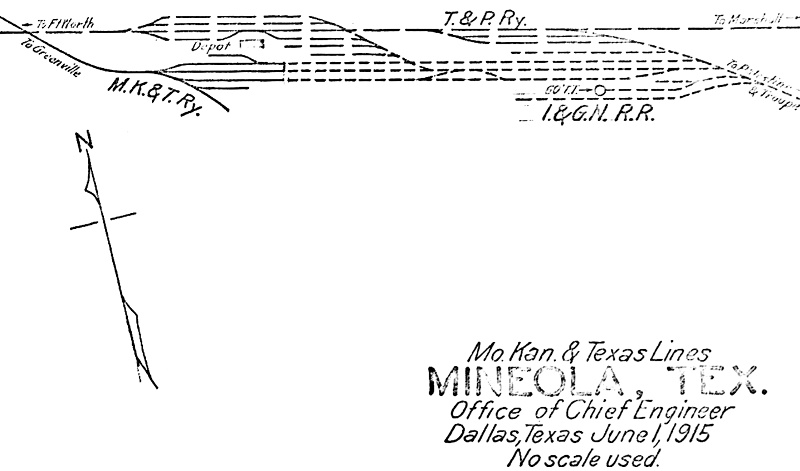
On September 27, 1915, the Katy Railroad went into
receivership. A comprehensive report on the condition of the company and its
options for regaining solvency was commissioned by the Receiver and prepared by
consultant J. W. Kendrick of Chicago. Kendrick's report, delivered in January,
1917, succinctly described the problem that led to the Katy's financial woes.
Simply put, the Katy was "Built originally as a granger
line, with grades conforming...to the general surface of the territory...with
rails of light sections and odd weights, with narrow banks and cuts...wet and
undrained, with bridges much too light...with light engines...of antiquated
design...unwisely purchased...by administrations which utterly failed to
recognize the coming changes in transportation methods... handicapped by
extraordinary interest charges upon...nondescript indebtedness, so large as to
make it necessary to starve the property...maintenance in order to keep it
solvent..." Kendrick noted that the Katy's "...payment of dividends was
commenced in 1906 and continued until 1914, during which time $4,160,000 was
dispensed to stockholders that should have been returned to the property in the
form of well conceived improvements..." In short, the railroad had been
severely mismanaged, leaving it physically and financially non-competitive.
In discussing freight opportunities, Kendrick's report mentioned that
"...lignite, or semi-bituminous coal, is produced in large quantities on the
Mineola Branch..." What Kendrick did not know was that the rapidly
developing petroleum industry, and the expansion of the availability of
electricity as a source of power, led to a sharp recession for Texas lignite
beginning in 1920. Kendrick also mentioned "...manufacture of boxes and
fruit and vegetable containers..." as a business in Mineola that provided
freight to the Katy, but this was hardly enough to keep the line busy. And while
Kendrick's data showed the Katy received more carload tons of freight from T&P
than from than any other railroad, it is likely that the vast majority of this
interchange was in Fort Worth and Dallas, where both railroads had a sizeable
presence. Kendrick also mentioned that the Katy was paying 1/3rd of the costs of
operating the Mineola passenger station.
The year when Katy traffic
across Tower 62 peaked is unknown, but it had substantially declined by the
early 1920s. The line was still viable as a lightly used branch, and it would
not be abandoned until 1956. Yet, with limited Katy traffic across the Tower 62
diamond, the railroads decided to eliminate the manned interlocking tower and
replace it with a cabin interlocker. This would save the substantial cost of
labor for tower operators and also reduce maintenance expenses. On November 26,
1922, T&P activated a new cabin interlocker to replace the existing interlocking
plant in Tower 62. Cabin interlockers were very efficient for situations in
which a lightly used rail line (e.g. the Katy branch from Greenville) crossed a
busy line (e.g. the T&P main line.) The controls for a cabin interlocker would
typically be located in a small trackside hut or cabin that would be accessed by
a trainman. The signals would normally be left so that T&P trains had continuous
authority to operate through the crossing unimpeded. When a Katy train needed to
cross the T&P, the Katy train would stop prior to reaching the diamond and one
of its trainmen would disembark, enter the cabin, and set the controls to grant
permission for the Katy train to cross. This action also signaled any
approaching T&P train to stop. When the Katy train had completely crossed the
diamond, the trainman would reset the controls to once again permit unimpeded
movements for T&P trains across the diamond.
The Tower 62 operators who
lost their jobs filed a complaint with the United States Railroad Labor Board.
Their argument was simply that the railroads had essentially built a new tower
(the cabin interlocker) with the same manual controls as the ones in the old
manned tower. But the controls in the new tower were being operated by train
crewmembers instead of members of the tower operators' union, the Order of
Railroad Telegraphers, as required by their contract with the railroads. The board
decision issued on November 23, 1925 describes the situation:
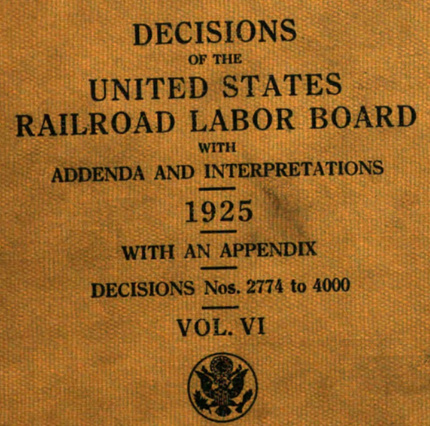
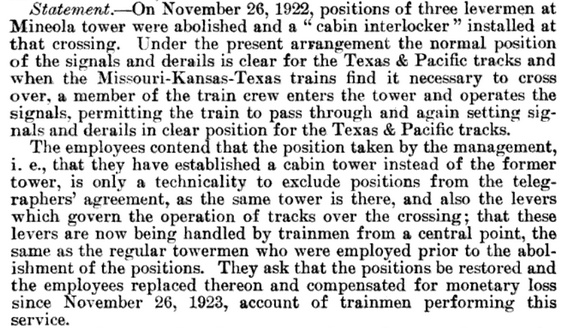
The tower operators
lost their case; the cabin interlocker would remain in service. Normally,
that would suggest that the former manned tower structure would not be allowed
to remain standing much longer, but eyewitness evidence suggests otherwise. A
few years ago, Mineola resident Joyce Alexander
Williams interviewed two life long residents of Mineola for their recollections
of any tower structure near the Katy/T&P crossing. Wayne Collins and Larry Barlow
both stated that they recalled the tower and that it was located on the south
side of the diamond. Wayne Collins is certain that the tower was removed between
1941 and 1945 because it was there when he left for World War II military service and it was gone when he returned.
At various times through various holdings, the T&P, the I-GN and the Katy
had all been controlled by railroad magnate Jay Gould, as had another railroad,
the Missouri Pacific (MP). MP was the largest of this group, but it had no
presence in Texas. When the Gould family lost control of the MP in 1917 (Jay had
died in 1892; his son George took over), MP management
began to pursue the others as a means of gaining access to the Texas market. MP
started by procuring T&P stock in 1918, and by 1930 owned a majority interest.
Coming out of a recent receivership, the I-GN was procured by the New Orleans,
Texas & Mexico (NOT&M) Railway, one of the Gulf Coast Lines that had been
founded by Texas railroad legend B. F. Yoakum. Six months later, on January 1,
1925, MP bought the NOT&M, adding the I-GN to its system along with several
other railroads in Texas and Louisiana. In 1976, the T&P was formally merged
into MP, and six years later, Union Pacific (UP) acquired MP. Through all of
these decades, the Katy remained independent. Its fortunes though had begun to
decline dramatically in the late 1960s. It was simply too small to be
competitive, yet it held on until 1988 when it was acquired by UP.
The
entire Katy branch from Greenville to Mineola was abandoned by Katy in 1956. In
1968, MP decided to abandon eleven miles of track between Mineola and Lindale.
The original I-GN / T&P interchange at Mineola was no longer needed. MP
controlled the T&P and they had better locations to exchange traffic e.g.,
Longview, Dallas and Fort Worth. Service to Lindale was provided by trains from
the MP main line at Troup via Tyler. Through all of this, the T&P main line has
remained in continuous operation, currently an important component of UP with
substantial daily traffic.
1957 Composite Aerial
Image of Tower 62 Approaches, with Annotations

Above:
This composite image from 1957 aerial photography ((c) historicaerials.com)
shows the path of the Katy, T&P and I-GN railroads through Mineola. The Katy
had been abandoned between Mineola and Greenville only a year earlier, so the
right-of-way remained easily visible. The tower was gone by 1957, but the acute
angle of the crossing (red arrow) it served is readily visible.
Tower 62 Foundation


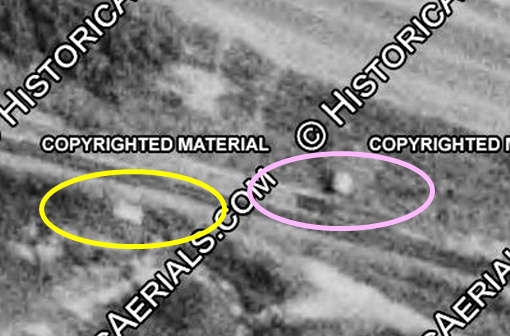
Above Left and Center: What
appears to be the concrete base for the original Tower 62 still exists on
the west edge of Mineola about 1/4 mile west of Cheek Street. The photos show
the west face (left) and south face (center) of this foundation. (photos c.2002 by Myron Malone)
Above Right: This
magnification ((c)historicaerials.com) from the 1957 composite map shows the
abandoned Tower 62 crossing of the Katy and the T&P. A possible rectangular foundation
(yellow oval) is visible
on the south side of the T&P tracks. The lack of a shadow makes it less
likely to be a structure. On the north side of the T&P tracks, a structure is
visible (pink oval) casting a small shadow to the west. Without knowing the day
of the year and time of day, the shadow cannot be used reliably to estimate the
height of the structure. But by the shape of the structure, it could easily be the cabin interlocker that
replaced the manned tower's functions in 1922. Since the Katy was abandoned only
a year before this photograph was taken, the cabin, sans interlocking plant and
controls, would likely have remained in place.
Below: The Tower 62 crossing was at an acute angle. When
the highway was built through Mineola, it paralleled the north side of the Katy
right-of-way (ROW) for a mile west of the diamond before crossing over it. The
highway was following the T&P into Dallas whereas the Katy would curve to the
northwest toward Greenville.
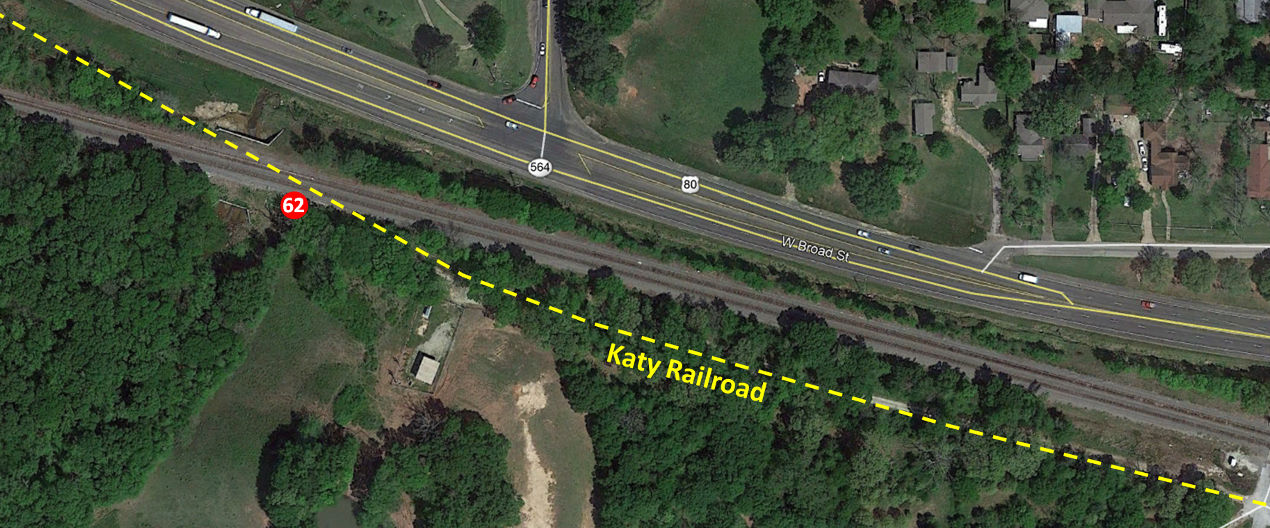
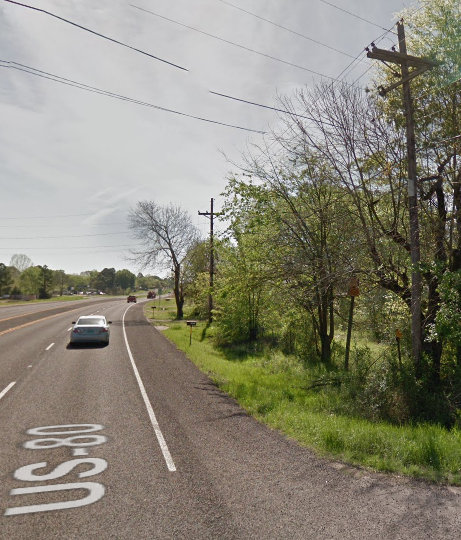
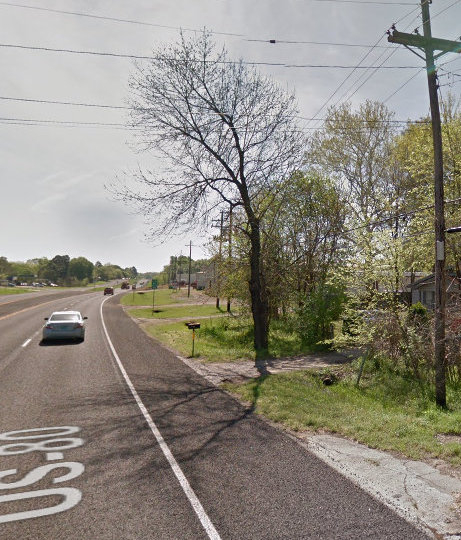
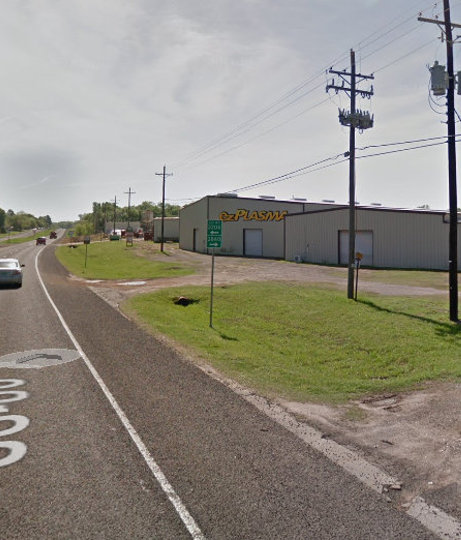
Above Left to Right: Eastbound on US 80 coming into
Mineola, the highway curves where the Katy railroad formerly crossed at grade on
an acute angle, becoming parallel to the road. The utility poles in the left photo are relatively close to the
highway, perhaps ten feet from the paved edge of the shoulder, because the Katy
has not yet crossed. In the center photo farther east, the camera is essentially
looking straight down the Katy ROW. Judging the distance between the pavement
and the utility poles, the nearby utility pole is still relatively close to the
pavement but the
poles in the distance are significantly further away. In the right photo farther to the east, the Katy ROW
is probably
somewhere to the right of the white stripe. It's possible that the utility poles, which are now perhaps 30
feet from the edge of the roadway, sit on the elevated grade, or perhaps the
apparent elevation is merely an artifact of the road construction. The tracks
(and certainly the original telegraph poles) were in place long before any
highways were built, but how well
graded/elevated this line was has not been determined. Since the Katy's abandonment in 1956, US 80 has been
widened into a
divided highway east of the apex of the curve in this section. This road reconstruction likely encroached on the
edges of the ROW, but it appears that most of the additional real estate required
was taken from the north side of the highway. The Katy ROW real estate was
essentially left intact along the south side, although the grade itself was
obliterated by various improvements
(e.g. drainage.) (Google Street View)
Below: Northwest of Mineola, a
1919 double-arched masonry culvert carried the Katy tracks. As noted above, the
Katy was in receivership at this time. Bridge and right-of-way reconstruction
investments were authorized by the Receiver to repair and improve the Katy's
physical infrastructure into a competitive posture. Numerous such culverts were
rebuilt in the vicinity of Mineola. This one is between Mineola and Lake
Holbrook. (Joyce Alexander Williams photo)














